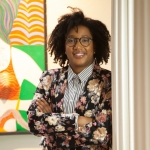
María López De León
Changing a Dominant Evaluation Paradigm
Posted by Jul 27, 2017

María López De León
Aesthetics and their interpretation are defined by institutionalized notions of excellence, and when artistic work speaks to social justice or traditional practices, its creative aspects are often considered lacking the value assigned by entrenched evaluation standards and practices. The Aesthetic Perspectives framework takes the conversation of evaluation to the next phase as it broadens the frame and brings forth a holistic approach to include and honor alternative attributes to define excellence in arts for change.
Read More
































